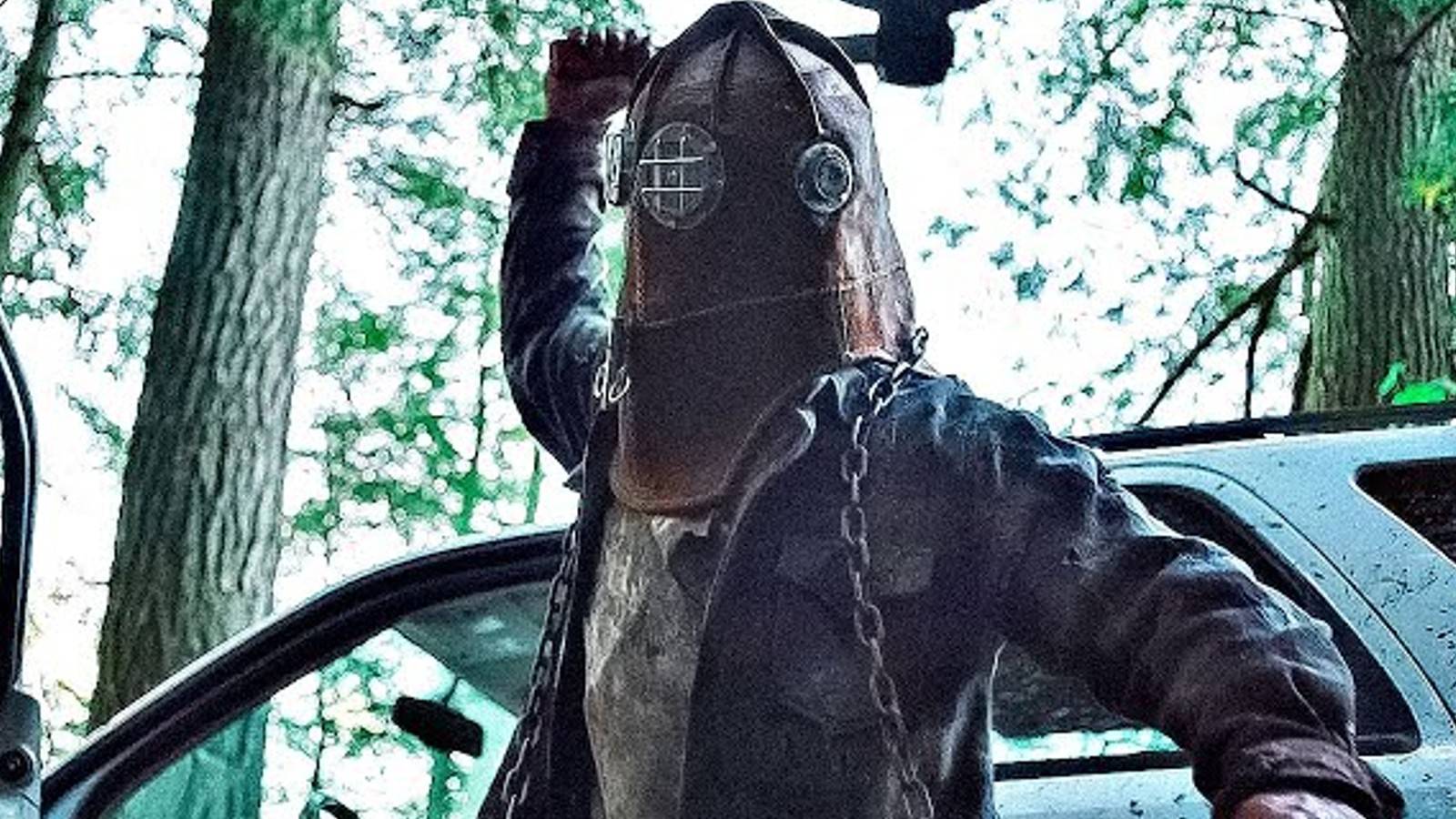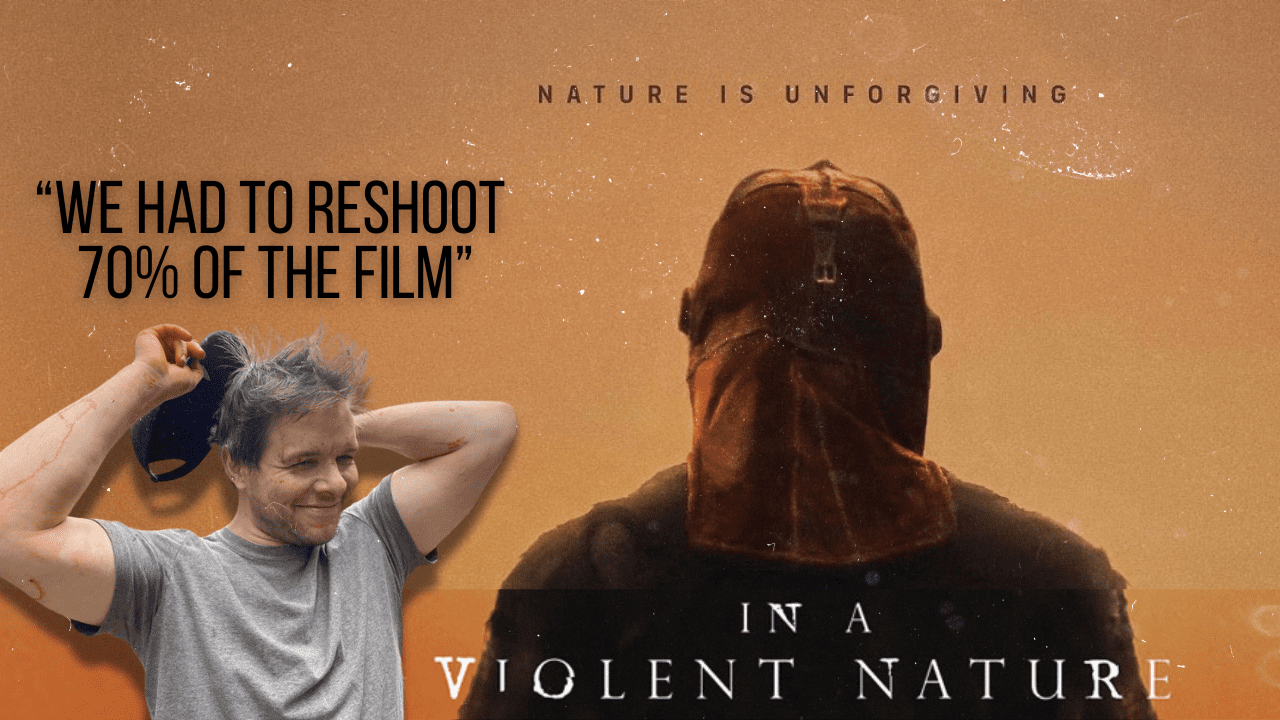In a Violent Nature Film Review
In a Violent Nature Film Review | In a Violent Nature is a slasher film like you’ve never seen before. Canadian director Chris Nash has crafted a project that subverts the classic slasher tropes, offering a fresh and [at times] experimental take on the genre.
Full Review in Video
Full Interview with Chris Nash HERE
Subverting Expectations
Unlike typical slasher films, In a Violent Nature is mostly shot from the point of view of the killer. This approach provides a new level of tension, as the audience follows the killer’s slow, methodical journey through the woods, reminiscent of an apex predator stalking its prey. The film still delivers the classic slasher kills, but the suspense is built from the killer’s perspective, rather than the victims’ attempts to escape.
The film premiered at the Sundance Film Festival and has been shown at various other festivals worldwide. It’s currently in limited theatrical release and is expected to be available on Shudder by the end of June, although an official date has yet to be announced. I had the opportunity to chat with Chris Nash about this project, and our conversation provided fascinating insights into the creative choices behind the film.
Making Creative Choices
One of the first things I asked Nash was whether it was difficult to get this unconventional project made. The film not only subverts genre norms by being shot from the killer’s point of view but also employs a 4:3 aspect ratio and has no musical score. These choices could have made production challenging, but Nash was fortunate to have a supportive production team.
Chris Nash on Getting It Made
“There were a lot of things that we thought we were going to brush up against, like within the inception of the actual film,” Nash explained. “We were like, okay, well we want to shoot in 4:3, and the reason that we wanted to shoot it in a 4:3 aspect ratio was trying to tap into all these slasher tropes and really getting the feel of how I felt watching like the Friday the 13th movies as a kid. We didn’t watch them in widescreen in 4K; we watched them on a crappy VHS on a CRT TV. We also decided not to have a musical score, and the production team was like, okay, do what you want”.
These decisions elevate the film beyond a typical slasher, giving it the pacing and feel of a slow art-house picture. The lack of a musical score and the camera work contribute to this atmosphere.

An Arthouse Feel
In In a Violent Nature, we spend a lot of time with the killer, Johnny, as he tracks his victims. This perspective feels almost like watching a nature documentary, where the audience must stay attentive, not knowing when the action will occur. Throughout, Nash is not afraid to buck traditional filmmaking advice. Characters are sometimes pushed to the edge of the frame, with slow, creeping camera movements that heighten the experience when viewing the film through the lens of a killer.
One memorable scene involves the camera circling a group of twenty-somethings around a campfire, creating a sense of a predator stalking its prey.
Problems While Shooting
While the pre-production process was smooth, the same cannot be said for the shoot. Approximately 70% of the film had to be reshot due to unforeseen issues. The original lead actor playing the killer had a medical emergency, forcing Nash to recast the role after nearly completing the project. Additionally, the original director of photography (DP) left, and Pierce Derks stepped in to take over. Derks used new cameras, resulting in an almost entirely new film.
Chris Nash on Reshooting the Film
“We did four weeks of shooting in a completely different location with a different lead actor,” Nash said. “He’s in a costume the entire film; if we can find somebody the same size, same build roughly, then we could get away with doing this. But there are so many things with the performance that are important, in just how they carry themselves, the gate of their walk, just the weight of their footfalls. All of that mattered so much, and we didn’t realize how much that mattered until we did a rough assembly of those first four weeks and we could see the stark differences.”
Nash also wanted to shoot the film in Northern Ontario, his hometown, to use the specific wilderness there. The change in location during the reshoot allowed him to fulfill this vision, although it added to the complexity of the production.
“I’d always envisioned this to be shot in Northern Ontario using that kind of wilderness,” Nash said. “That’s where I’m from, and it’s where, in my brain, I set a lot of any project that I do. Where we were shooting it just didn’t have the same feel. The trees didn’t feel the same; everything kind of just felt different and a little too uncanny for what I wanted.”
Despite the challenges, everything worked out in the end. However, some elements had to be modified or abandoned due to time and budget constraints. The ending, in particular, was supposed to be grander but ended up being more subdued and minimalist.
Chris Nash on Making Tough Decisions
“There’s a death that happens on a lake, and originally, that was conceived as being like a much more elaborate shot where we’re having a camera travel over top of the water and everything’s like one big unbroken take,” Nash explained. “Logistically, there were just way too many issues with that. We kept making concessions and we kept attempting and things were going wrong, one after another, until it got to the point where we still needed to fill this space in the film. We had attempted to shoot it many times, all to failure, and then we were just like, okay, we’ll just have to go very minimalist with this and just lock off the camera in one corner and shoot it much differently than we originally conceived. It made us reexamine what the film is and what the tone is.”
Nash admitted that the final ending was envisioned to be much different. “The original ending was supposed to be a giant set piece with buildings lit on fire and just death incarnate going around,” he said. “But that was proving to be a lot to handle, and time was running out. I was speaking with one of my friends, who’s also an incredibly talented filmmaker, Nate Wilson, and he asked if I had any other ideas for the ending. I was so frustrated I just thought, maybe I should end it in a very unceremonious but mean and aggressive, and even kind of a funny way. Something that people don’t expect and not tied up in a nice bow like everyone wants it to be.”
These changes, while challenging, ultimately helped refine the film’s tone and focus.
Who is This Film For?
The ending of In a Violent Nature reflects the film’s overall approach—subverting expectations and taking risks. Some viewers will love it for these qualities, while others may find it too far outside of their expectations.
However, if you are a fan of traditional slashers, there’s still plenty here to enjoy, including some extremely creative and gruesome kills. My personal favorite was the lookout scene. Without going into spoilers, it’s a moment that had me with my mouth agape for what seemed like minutes.
Similarly, If you appreciate art-house films or enjoy discussing creative cinematic choices, In a Violent Nature will likely be a compelling watch. Nash’s unique choices, such as the 4:3 aspect ratio and the absence of a musical score, create a distinctive atmosphere that sets this film apart from other slashers.
Nash’s commitment to his vision, even when faced with significant challenges, is evident throughout the film. The meticulous attention to detail, from the framing of shots to the sounds of nature that replace a traditional score, makes In a Violent Nature a standout in the genre. The film’s willingness to deviate from conventional slasher norms might alienate some viewers, but it will undoubtedly resonate with those who appreciate a more nuanced and experimental approach to storytelling.
Conclusion
In a Violent Nature is a unique venture in the slasher genre, and I’m glad it was made and is being seen. Its innovative approach to the slasher narrative, combined with its art-house aesthetic, makes it a must-see for fans of the genre and cinephiles alike. Nash’s dedication to subverting expectations and creating a film that challenges traditional horror tropes is both admirable and refreshing.
Catch In a Violent Nature in theaters now or on Shudder at the end of June. Whether you’re a fan of slasher films, art-house cinema, or simply looking for something different, this film is sure to leave a lasting impression. | In a Violent Nature Film Review
More Videos HERE
Full Written Reviews HERE





Pingback: In a Violent Nature: Introduction and Conclusion – Maryland News
Ok but needs more than a few kills to become an franchise